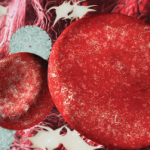Part of our underdog team’s brilliance is its incorporation of the PET Vascular Activity Score (PETVAS), a novel scoring system designed to provide qualitative assessment of arterial uptake in four aortic segments and 11 branch arteries compared with liver uptake on FDG-PET scans (Note: This analysis was only performed for FDG-PET-CT). Each segment receives a 0–3 score that is summed to create the PETVAS score. Higher scores, which are indicative of increased vascular inflammation, were felt to correlate well with visual interpretation of active vs. inactive vasculitis on FDG-PET-CT scans (P<0.0001). One highlight: A PETVAS score greater than 20 predicted a clinical relapse over a median time frame of 15 months in patients who were otherwise thought to be in clinical remission (i.e., 55% of patients with a score of >20 had a clinical relapse compared with 11% of patients with a score of <20 who had a clinical relapse).
With the ball in their court, Quinn et. al compared FDG-PET to magnetic resonance angiography (MRA) in patients with LVV and found FDG-PET superior in reliably detecting disease activity and that FDG-PET enhancement was more likely than MRA to correlate with active clinical disease assessment. However, MRA was superior in detecting the extent to which disease was involved in vascular territories due to its ability to detect arterial wall and lumen abnormalities.2 When comparing FDG-PET to computed tomography angiography (CTA), FDG-PET was more sensitive and detected more involved arterial segments than CTA.3
FDG-PET is not disease specific but can detect inflammatory, infectious and malignant conditions. Thus, it needs to be cautiously interpreted. A minimum of 60 minutes is recommended from intravenous 18F-FDG administration to image collection for adequate tracer distribution.4 Additionally, our potential Achilles heel is glucocorticoid use, a cornerstone of LVV treatment because it reduces metabolic cell activity and 18F-FDG uptake, which can result in a significant decrease in signal after three days of treatment.5
Implications
FDG-PET is a cutting-edge modality with the potential to change the game of LVV. It demonstrates impressive sensitivity and specificity in capturing active LVV, allowing quantification of activity with PETVAS and predicting the risk of relapse for patients thought to be in remission.
In the future, we hope to see standardization of FDG-PET protocols for LVV, qualitative scoring and additional prospective longitudinal studies using FDG-PET scans at time of diagnosis. Then, serial monitoring to see if abnormalities on FDG-PET scans truly correlate with poor, long-term clinical outcomes.



